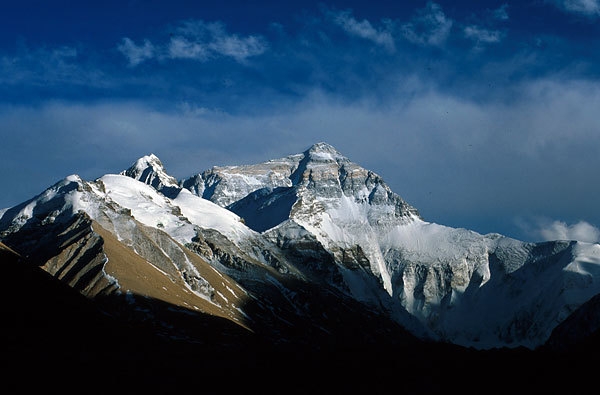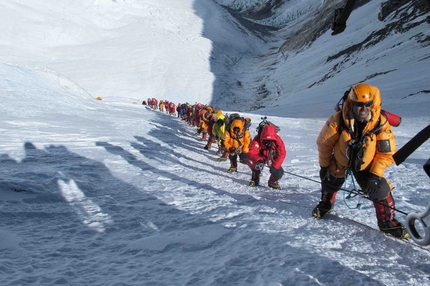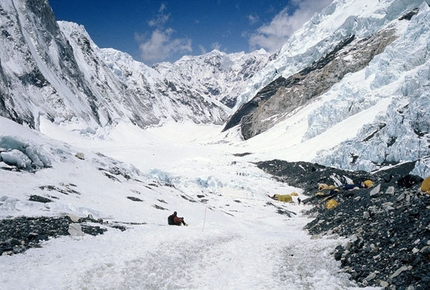Everest 60 years between legend and business
On May 29, 60 years ago Tenzing Norgay and Edmund Hillary stood on top of the world for the first time ever. Since then Everest has continued to be a symbol, hovering somewhere between a legend and "consumerism". By Erminio Ferrari.

 1 / 8
1 / 8
Everest from the north.
 Francesco Tremolada
Francesco Tremolada
May 29, 1953. "We went on slowly, steadily. And then we were there. Hillary stepped on top first. And I stepped up after him." After coming so close in 1952 with Switzerland's Raymond Lambert, Tenzing Norgay finally reached the summit of Everest, the highest mountain in the world, together with Edmund Hillary. The dream of a lifetime for the young Sherpa, and a golden opportunity for the beekeeper and expert Himalayan mountaineer from New Zealand.
Neither of them were English. But shrewd handling resulted in the news taking five days to reach London, in time therefore for the coronation of Queen Elizabeth II: this British "victory" on the roof of the world resounded throughout the remains of the empire like a symphonic march by Elgar or a baroque flutter by Händel.
Sixty years on and with more than five thousand climbers having reached its 8848 metre summit, nowadays Mount Everest makes headline news that go well beyond the mountaineering chronicles in the strictest sense. The symbolic importance of the "roof of the world" still holds firm (after all, it still is Chomolungma for the Tibetans, the "Goddess Mother of the Earth", or Sagarmatha for the Nepalese, "Mother of the Universe"), as does the rhetoric of that "uselessness" that climbers strive to conquest; a final, stupendous and at times obsessive game against themselves that lies at the root of every adventure (or supposedly so). But the "glory" - the one that John Hunt, the leader of the successful 1953 expedition - wanted to share with the Swiss who a year earlier had "paved the way", well that glory does not belong to this era.
After having been at the centre of ascents that made history (the first without oxygen and the first solo ascent, both by Reinhold Messner; the winter ascents, by the Poles; the traverses, ridges and faces) Everest's flanks hosted the competitions for the fastest ascent, the youngest, the oldest, the first telephone call from the summit, the first live TV broadcast, the first ski descent, the first paraglide flight (well, the Swissmen Loretan and Troillet slid down the north face on their bottoms, but only because they were in a hurry). The list continues with the guy who set off from home (in Sweden) by bicycle, reached the summit on foot and returned home riding his bike once again; and then there was the one who wanted to ride his bike all the way up the mountain. And last but not least, the first Saudi climber, without a veil but with an oxygen mask. Everest has evolved into being sought after by hundreds of wealthy high altitude tourists (as Messner put it) who all line up, clinging to the fixed ropes, relying on specialised agencies for assistance from guides, on the porters' efforts, on logistical support, gear, oxygen and - if all goes well - fifteen minutes of fame when they return home. When things go wrong, they confront frostbite, edema and sometimes death.
A death that is no longer as it once used to be: one no longer dies for History but for the chronicles. And sometimes not even for that: anonymous deaths, along from thoroughfare, by mass civilization, as shown by the photographs of the corpses unburied if not by the snowfall, the dying, left to themselves, overtaken by the groups to which the power was just enough to advance, let alone stop and render assistance. Unless one dies in large numbers and close by there is a talented journalist, such as Jon Krakauer, who in his Into Thin masterfully narrated Air great prejudices and some inaccuracies about the 1986 tragedy.
Business, if anything, certainly not glory. And you certainly cannot reprimand good old Tenzing for not having foreseen, or worse still, for not have used it as an argument to convince the reluctant sherpa, "It's you who do not understand" - he remembers having said to his countrymen, in his autobiography dictated to James Ramsey Ullman, the greatest Everest historian. "If the Everest will be climbed, the Himalayas will become famous all over the world. There will be more expeditions and more work than ever." In retrospect one always says that the roads to disaster are always paved with the best intentions. But if that's the case...
Nowadays the Sherpa are the driving force behind a lucrative deal called the climb to the roof of the world. But their world has changed considerably, both in the valleys that lead to Everest and, even more so, up on the mountain itself. The aggression (at 7000 meters!) that took place at the end of last April involving Simone Moro, Ueli Steck and Jonathan Griffith ("guilty" for having overtaken the Sherpa teams who were fixing the ropes for commercial expeditions) has proven this in the least accommodating and most traumatic manner.
The result was the explosion, in this "extreme" and therefore not manageable situation, of the contradictary relationship between alpinists and "locals"; contradictions which are larger than individual responsibilities or good faith. In doing so, a comfortable oleography was demolished once and for all which had served both the Nepalese Tourist Office well, as well as the conscience of homeward bound Westeners.
The mild Sherpa has become a bady, while capable mountaineers are exploiters. And once again we're back to the legend of the expulsion from Garden of Eden. But not without a cost, this must be understood: "before" the attack on Moro and his companions, a Sherpa died fixing the route through the Ice Fall; "afterwards" another Sherpa died of an edema after having transported food and gear to the high camps for mountaineers who, in the days that followed, would attempt to reach the summit.
by Erminio Ferrari
Neither of them were English. But shrewd handling resulted in the news taking five days to reach London, in time therefore for the coronation of Queen Elizabeth II: this British "victory" on the roof of the world resounded throughout the remains of the empire like a symphonic march by Elgar or a baroque flutter by Händel.
Sixty years on and with more than five thousand climbers having reached its 8848 metre summit, nowadays Mount Everest makes headline news that go well beyond the mountaineering chronicles in the strictest sense. The symbolic importance of the "roof of the world" still holds firm (after all, it still is Chomolungma for the Tibetans, the "Goddess Mother of the Earth", or Sagarmatha for the Nepalese, "Mother of the Universe"), as does the rhetoric of that "uselessness" that climbers strive to conquest; a final, stupendous and at times obsessive game against themselves that lies at the root of every adventure (or supposedly so). But the "glory" - the one that John Hunt, the leader of the successful 1953 expedition - wanted to share with the Swiss who a year earlier had "paved the way", well that glory does not belong to this era.
After having been at the centre of ascents that made history (the first without oxygen and the first solo ascent, both by Reinhold Messner; the winter ascents, by the Poles; the traverses, ridges and faces) Everest's flanks hosted the competitions for the fastest ascent, the youngest, the oldest, the first telephone call from the summit, the first live TV broadcast, the first ski descent, the first paraglide flight (well, the Swissmen Loretan and Troillet slid down the north face on their bottoms, but only because they were in a hurry). The list continues with the guy who set off from home (in Sweden) by bicycle, reached the summit on foot and returned home riding his bike once again; and then there was the one who wanted to ride his bike all the way up the mountain. And last but not least, the first Saudi climber, without a veil but with an oxygen mask. Everest has evolved into being sought after by hundreds of wealthy high altitude tourists (as Messner put it) who all line up, clinging to the fixed ropes, relying on specialised agencies for assistance from guides, on the porters' efforts, on logistical support, gear, oxygen and - if all goes well - fifteen minutes of fame when they return home. When things go wrong, they confront frostbite, edema and sometimes death.
A death that is no longer as it once used to be: one no longer dies for History but for the chronicles. And sometimes not even for that: anonymous deaths, along from thoroughfare, by mass civilization, as shown by the photographs of the corpses unburied if not by the snowfall, the dying, left to themselves, overtaken by the groups to which the power was just enough to advance, let alone stop and render assistance. Unless one dies in large numbers and close by there is a talented journalist, such as Jon Krakauer, who in his Into Thin masterfully narrated Air great prejudices and some inaccuracies about the 1986 tragedy.
Business, if anything, certainly not glory. And you certainly cannot reprimand good old Tenzing for not having foreseen, or worse still, for not have used it as an argument to convince the reluctant sherpa, "It's you who do not understand" - he remembers having said to his countrymen, in his autobiography dictated to James Ramsey Ullman, the greatest Everest historian. "If the Everest will be climbed, the Himalayas will become famous all over the world. There will be more expeditions and more work than ever." In retrospect one always says that the roads to disaster are always paved with the best intentions. But if that's the case...
Nowadays the Sherpa are the driving force behind a lucrative deal called the climb to the roof of the world. But their world has changed considerably, both in the valleys that lead to Everest and, even more so, up on the mountain itself. The aggression (at 7000 meters!) that took place at the end of last April involving Simone Moro, Ueli Steck and Jonathan Griffith ("guilty" for having overtaken the Sherpa teams who were fixing the ropes for commercial expeditions) has proven this in the least accommodating and most traumatic manner.
The result was the explosion, in this "extreme" and therefore not manageable situation, of the contradictary relationship between alpinists and "locals"; contradictions which are larger than individual responsibilities or good faith. In doing so, a comfortable oleography was demolished once and for all which had served both the Nepalese Tourist Office well, as well as the conscience of homeward bound Westeners.
The mild Sherpa has become a bady, while capable mountaineers are exploiters. And once again we're back to the legend of the expulsion from Garden of Eden. But not without a cost, this must be understood: "before" the attack on Moro and his companions, a Sherpa died fixing the route through the Ice Fall; "afterwards" another Sherpa died of an edema after having transported food and gear to the high camps for mountaineers who, in the days that followed, would attempt to reach the summit.
by Erminio Ferrari
Latest news
Expo / News
Expo / Products
Ever since its market launch, the Barryvox avalanche transceiver has been among the most reliable transceivers in the world.
Scott skis, light enough for ski touring, and shaped for freeride skiing.
The ultimate shell pants for any winter outing.
The Guida HDry gloves are the evolution of the Guida model, enhanced with HDry technology, making them ideal for all weather conditions.
Technical footwear for high altitude mountaineering and ice climbing.
A lightweight mountaineering backpack for demanding conditions and terrain.



 Copia link
Copia link







 See all photos
See all photos






















